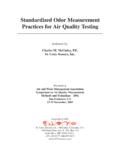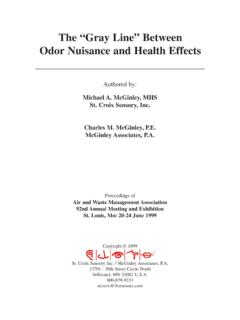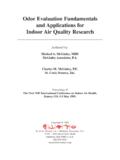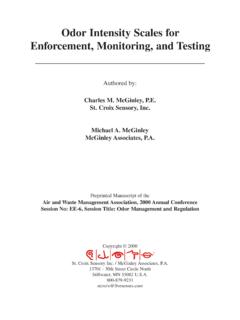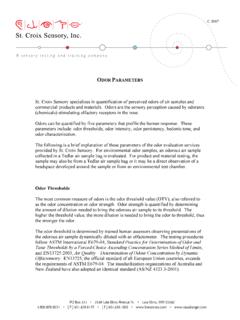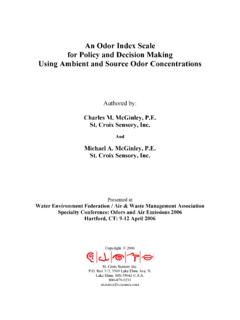Transcription of The New European Olfactometry Standard: Implementation ...
1 The New European Olfactometry Standard: Implementation , Experience, and PerspectivesAuthored by:Michael A. McGinleySt. Croix Sensory, M. McGinley, Croix Sensory, Manuscript of theAir and Waste Management Association,2001 Annual Conference Technical ProgramSession No: EE-6b,Session Title: Modeling, Analysis & Management of OdorsSt. Croix Sensory Inc. / McGinley Associates, - 30th Street Circle NorthStillwater, MN 55082 2001 1 ABSTRACT With the global increase of environmental regulations in the 1970 s, European countries,Australia, and the United States began to develop odor regulations.
2 These regulationscreated the need to standardize the methods of odor measurement. More recently, in the 1990 s the European Committee for Standardization (CEN) formeda technical committee (TC264) which developed and is expected to release a final odortesting standard in late 2001, entitled EN 13725: Air Quality-Determination of OdourConcentration by Dynamic Olfactometry . This standard, which will unify theolfactometry standards of 18 countries (Austria, Belgium, Denmark, Finland, France,Greece, Germany, Iceland, Ireland, Italy, Luxembourg, Netherlands, Norway, Portugal,Spain, Sweden, Switzerland, and the United Kingdom), follows ISO quality assuranceand scientific testing protocols.
3 Australia and New Zealand have combined to write anew standard essentially identical to the European consortium of odor laboratories in Canada and the United States initially approachedthe proposed European odor testing standard with skepticism. There were concernsregarding the presentation flow rate (20 lpm), the detailed statistical and proceduralrequirements, and the assessor screening and selection process that was based on onlyone standard odorant. However, the experience of adopting and applying the standardover the last five years has convinced these laboratories of the benefits of this oneunifying Olfactometry standard.
4 While Universities and other laboratories are movingtowards adopting the European Olfactometry standard, there is also a trend towards stateregulatory agencies in the also adopting the standard as an odor measurement toolfor monitoring and compliance ( Colorado, Minnesota). This new (draft) Europeanolfactometry standard, due for official acceptance and publication in 2001, is poised tobecome a global standard of Olfactometry for the testing of paper discusses implementing and utilizing the proposed (draft) EuropeanOlfactometry Standard (EN 13725) by a number of Canadian and US odor discussed include presentation air flow parameters, laboratory procedures, qualitycontrol statistics, and assessor screening and performance criteria.
5 2 INTRODUCTIONWith the global increase of environmental regulations in the 1970 s, European countries,Australia, and the United States began to develop odor regulations. These regulationscreated the need to standardize the methods of odor measurement. Some examples ofthese standards include: US - ASTM D-1391 (1978) and ASTM E679-91 (1991),Germany - VDI 3881 (1980), France - AFNOR - X-43-101 (1986), Netherlands -NVN2820 (1996).More recently, in the 1990 s the European Committee for Standardization (CEN) formeda technical committee (TC264) which developed and is expected to release a final odortesting standard in late 2001, entitled EN 13725: Air Quality-Determination of OdourConcentration by Dynamic Olfactometry .
6 This standard, which will unify theolfactometry standards of 18 countries (Austria, Belgium, Denmark, Finland, France,Greece, Germany, Iceland, Ireland, Italy, Luxembourg, Netherlands, Norway, Portugal,Spain, Sweden, Switzerland, and the United Kingdom), follows ISO quality assuranceand scientific testing protocols. Australia and New Zealand have combined to write anew standard essentially identical to the European consortium of odor laboratories in Canada and the United States initially approachedthe proposed European odor testing standard with skepticism.
7 These odor labs include: Agriculture Canada - Charlottetown, Prince Edward Island Alberta Research Council/University of Alberta - Edmonton, Alberta Duke University - Durham, North Carolina Iowa State University - Ames, Iowa Los Angeles County Sanitation Districts - Los Angeles, California Metropolitan Council, Environmental Services - St. Paul, Minnesota Purdue University - West Lafayette, Indiana St. Croix Sensory, Inc. - Stillwater, Minnesota University of Manitoba - Winnipeg, Manitoba University of Minnesota - St. Paul, MinnesotaThere were concerns regarding the presentation flow rate (20 lpm), the detailed statisticaland procedural requirements, and the assessor screening and selection process that wasbased on only one standard odorant.
8 However, the experience of adopting and applyingthe standard over the last five years has convinced these laboratories of the benefits ofthis one unifying Olfactometry standard. While Universities and other laboratories aremoving towards adopting the European Olfactometry standard, there is also a trendtowards regulatory agencies in the also adopting the standard as an odormeasurement tool for monitoring and compliance ( Colorado, Minnesota). This new(draft) European Olfactometry standard, due for official acceptance and publication in2001, is poised to become a global standard of Olfactometry for the testing OF THE European STANDARD"In the United States and throughout Europe in the 1970 s and 1980 s there was asignificant increase in public concern for odors from industrial, agricultural, and wastewater treatment facilities.
9 During this time, governments in many of these Europeancountries implemented standards and regulations for odors. Many of the regulationsrequired the measurement of odors through Olfactometry , either to prove compliance or tomeasure and monitor has been used throughout the 20th century in the medical researchcommunity. However, there has existed variability of results due to differences inolfactometer design and operating performance as well as the lack of consistency in odortesting methods the 1980 s countries in Europe began developing standards of Olfactometry .
10 Some ofthese standards developed and published include: FranceAFNOR X-43-101 (drafted in 1981 & revised in 1986)GermanyVDI 3881, Parts 1-4 (drafted in 1980 & revised in 1989)NetherlandsNVN 2820 (drafted in 1987 & issued in 1995)Various inter-laboratory studies as well as collaborative projects involving multiple odortesting laboratories in the 80 s showed that laboratory results still differed significantlyeven with these standards in development of a draft odor testing standard in the Netherlands led to an Inter-Laboratory Comparison study organized in N-butanol and hydrogen sulfide wereused as standard odorants for the study.
